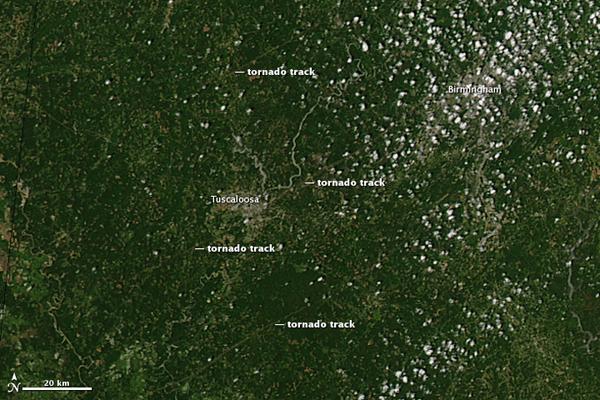
Why Were the Southern Tornadoes So Deadly?

Tornado-related deaths have declined dramatically over the past few decades due to improved forecasts and better warnings, but the massive outbreak on April 27 killed hundreds across the Deep South. What happened?
The bottom line: Massive tornadoes hit populated cities head-on. Forecasters had warned of an "insane" storm system for days, so it's unlikely that the tornadoes caught many by surprise. But with few basements in Dixie Alley, not many places were safe in the paths of tornadoes that had nearly 200-mph (322-kph) winds. Even solidly built houses were swept away. Many entire neighborhoods were completely obliterated. [The Tornado Damage Scale in Images]
"The truth is, even if you did everything you were supposed to do, unless you were in an underground bunker, you weren't going to survive," James Spann of the ABC affiliate in Birmingham, Ala., told the New York Times.
Vicious twisters
On Wednesday, more than 150 tornadoes were reported in the southeastern United States. Bob Henson, a meteorologist with the National Center for Atmospheric Research in Boulder, Colo., said he "wouldn't at all be surprised," to see some of those storms rated as EF-5, the highest rating on the Enhanced Fujita Damage scale, with winds faster than 200 mph.
Already, one tornado that killed 14 people in Smithville, Miss., has been given the top rating, the first EF-5 in the United States in three years.
The deadly combination of strength and location, with the populous cities of Birmingham and Tuscaloosa, Ala., has created one of the highest death tolls in decades.
Get the world’s most fascinating discoveries delivered straight to your inbox.
"Any tornado going through the heart of the city like that is going to cause major damage," Henson told OurAmazingPlanet.
Historic outbreak
The latest outbreak wasn't just a few tornadoes in a few small towns. Preliminary reports suggest that this outbreak could be among the biggest of all time. Tornadoes roared on the ground for hours and traveled miles between cities. One twister may have traveled the 60 miles (97 kilometers) from Tuscaloosa, Ala., to Birmingham.
"It looks like it was a very long-track tornado and those don't happen that often," Henson said.
That tornado could be responsible for most of Alabama's 228 reported fatalities. When the damage assessments are finished, the deadly outbreak will likely be the deadliest since 1974, when 308 people were killed. The deadliest outbreak of all time is believed to be the Tri-State Tornado of March 18, 1925, which killed 695 people in Missouri, Illinois and Indiana.
Those massive death tolls are rare today. Tornado-related deaths have plummeted as forecasts and warnings have become more precise. The 2000 to 2009 average for annual tornado-related fatalities is 62, according to the National Climatic Data Center.
Deadly Dixie
Dixie Alley, the focus of this year's tornado season, is notoriously deadly. Even a small tornado there can be deadly.
Unlike the flat, grass-covered plains of Tornado Alley, tornadoes are hard to see in Dixie Alley. Trees and hilly terrain obscure funnel clouds, a problem made even worse by the region's high rate of nighttime tornadoes, which can hit when people are sleeping.
Often, tornadoes can be cloaked in rain, hiding even the most massive twisters.
To make matters worse, Dixie Alley is home to many manufactured houses and mobile homes that have weak walls and poor -- or nonexistent -- foundations. Before the April 27 outbreak, more than half of this year's tornado-related deaths had occurred in mobile homes.
Storm surveys are still ongoing, but it's likely that mobile home deaths were common during the most recent tornado outbreak as well.
- Weirdo Weather: 7 Rare Weather Events
- Infographic: Tornado! An Inside Look at Tornado Season
- Why Aren't There Tornado Safety Building Code?
Reach OurAmazingPlanet staff writer Brett Israel at bisrael@techmedianetwork.com. Follow him on Twitter @btisrael.



